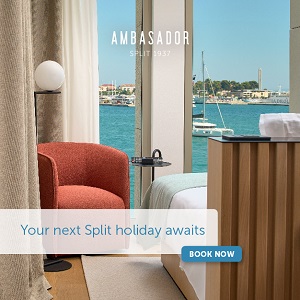Meet HGSS The Croatian Mountain Rescue Service
August 19, 2020 – All weather, all terrain, all year round – meet HGSS The Croatian Mountain Rescue Service, amazing volunteers who will never let you down
They're never far from the news. For the last two weeks, members of HGSS The Croatian Mountain Rescue Service have yet again been on the TV news every night. They're leading the search for a summertime visitor, a Polish hiker missing on Biokovo mountain.
But, watch again this winter and, for sure, they'll be in the headlines once more. Whether, they're scaling mountain ranges in the unbearable heat of high summer, searching underwater caves, flooded rivers or the sea, breaking through wild forest or trudging through metres of snow, they undertake their search and rescue missions over every terrain, in every weather condition, in every month of the year, all across Croatia. And, they all volunteers.
Marc Rowlands meets the head of service for HGSS The Croatian Mountain Rescue Service and three of its volunteers to find out who they are and what makes them do what they do.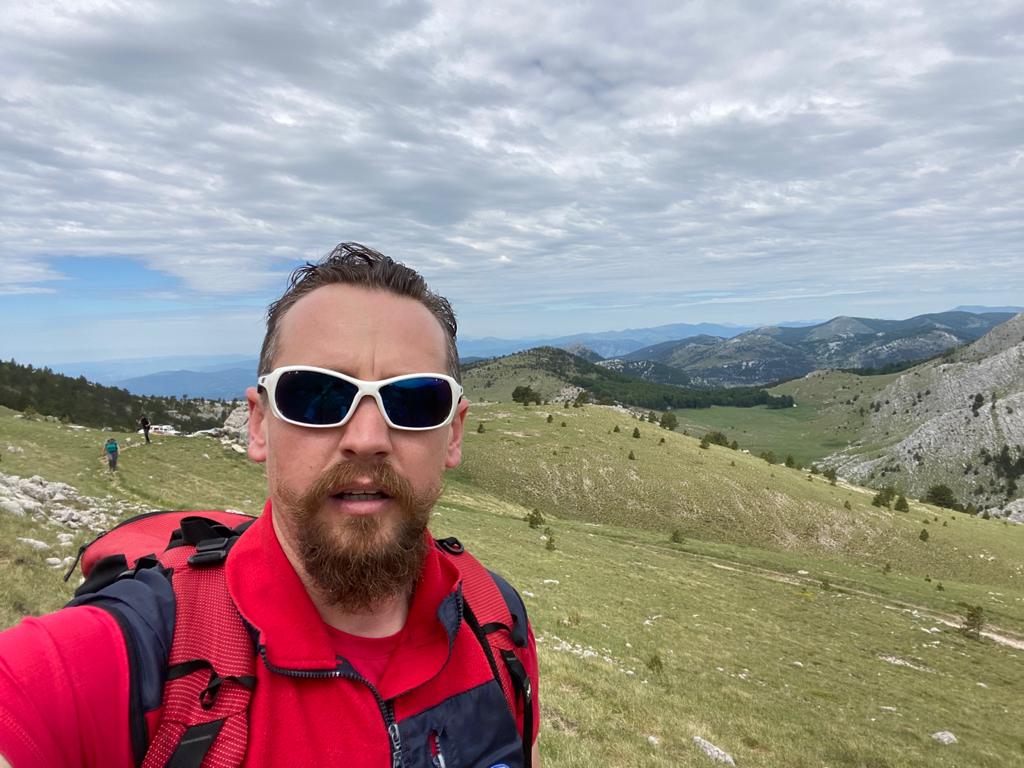
Josip Granić, head of service for HGSS The Croatian Mountain Rescue Service
My name is Josip Granić. I'm the Head Of Service for HGSS The Croatian Mountain Rescue Service. We've had an extremely busy couple of weeks. Being head of service for an organisation like this under such circumstances means you're always on the phone; co-ordinating, talking to outside organisations, members of the press. Communication. It's a 24/7 job, 365 days a year. If people need help, you can't take a holiday. Not at this level of the organisation.
We have around 1000 members. There are 11 paid positions in the main organisation and 25 people we pay to run the administration in each of the teams or stations we have. All of the members who perform the search and rescue are volunteers. We have pilots, surgeons, nurses, students, professors, every part of society.
I'm originally from Kaštela, but my home station is in Karlovac. I've been there for 15 years. I've been Head Of Service for two. Since I assumed the position, I've spent most of my time in the car. I travel all over Croatia.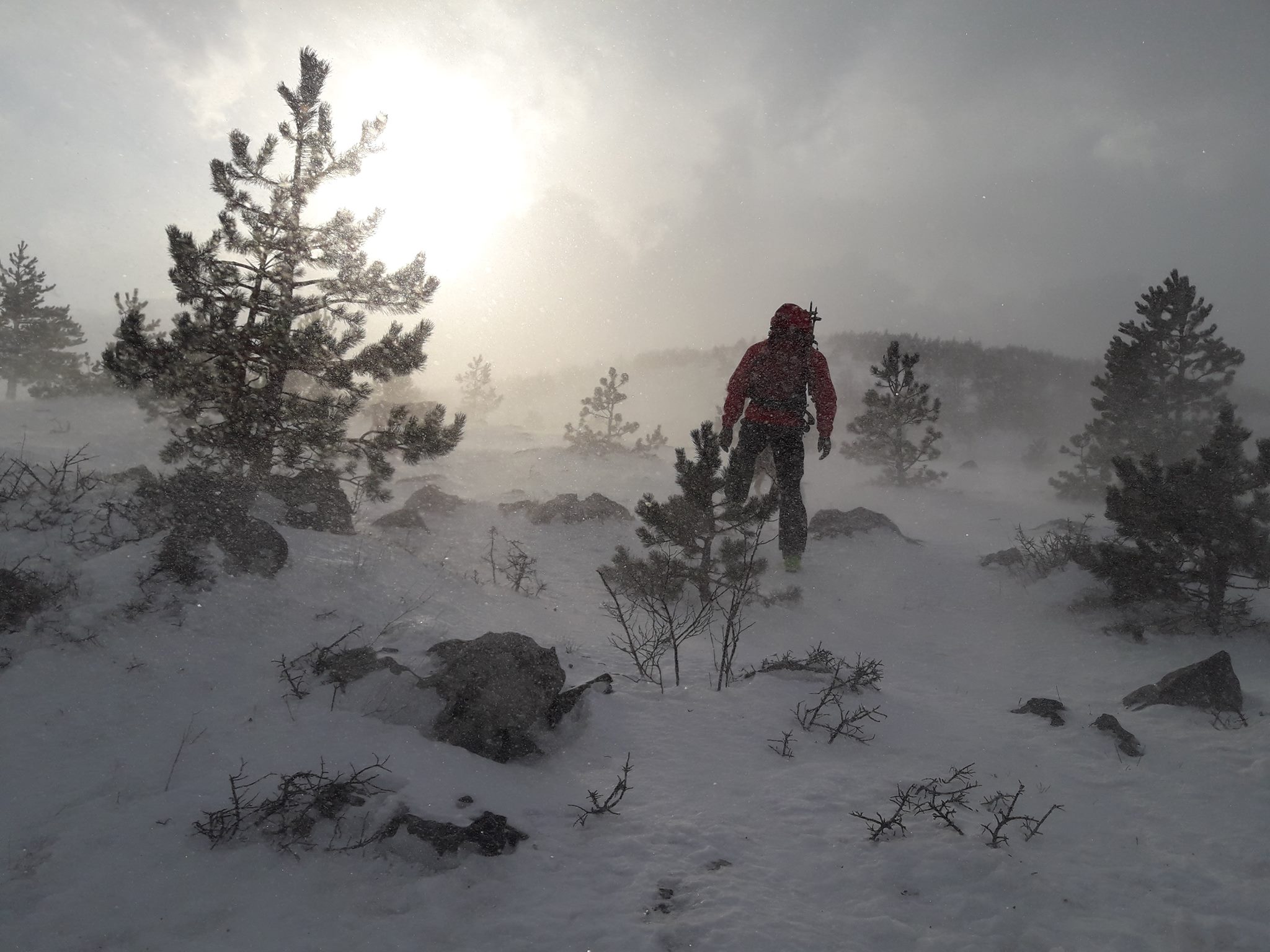
HGSS The Croatian Mountain Rescue Service missions can be hampered by extreme weather conditions © HGSS The Croatian Mountain Rescue Service
To get a certified position as a mountain rescuer in Croatia you all do the same training. It doesn't matter if you come from Slavonia, Dalmatia or Istria, you must have the knowledge and ability to deal with circumstances in any terrain; caves, pits, mountains, on snow, underwater.
Depending on where your station is, the type of call-outs you get could be very different. In Slavonia, 90% are for missing persons - searching forests, rivers, and in floods. We've had a big search on Biokovo mountain for the past 16 days. The stations from Split, Makarska, and Dubrovnik were at first involved, then teams from all over Croatia. It's not the same as Slavonia. The terrain is very different, so you have to be good at a particular set of skills. But, the largest percentage of call-outs is still missing persons. It's 70% of our work nationwide. The other 30% are rescues.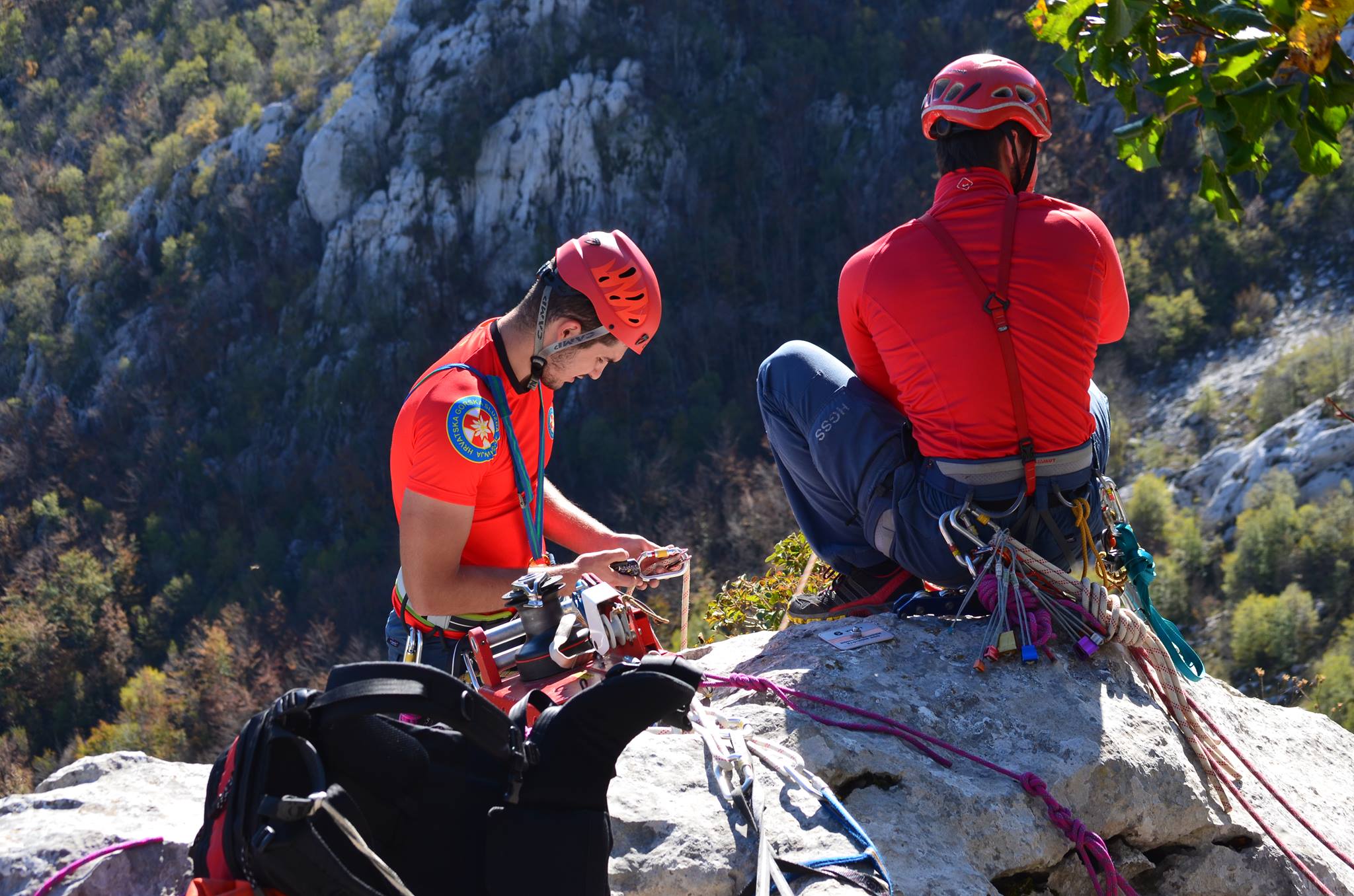
HGSS volunteers are educated to use a wide range of technical equipment. They are trained to operate in all the different kinds of terrain found across Croatia © HGSS The Croatian Mountain Rescue Service
There are usually 800 – 1000 missions a year across the country. We get roughly the same amount of calls in colder months as in warmer months. Only, winter months can be busier. The terrain is more difficult. There are some villages in Croatia – usually where the front line of the fighting was, around Karlovac, Kordun, Lika – and when it snows, it can be almost impossible to reach those places. But, some older people still live there. It can take days to reach them on snowmobiles, then skis, to deliver food or medecine. The other busiest places in winter are the ski resorts - Platak, behind Rijeka, and in Zagreb, on Sljeme. There are teams stationed in those places throughout the snow season.
What's the greatest danger of the job? Almost everything. Nothing in this job is easy. The greatest dangers we face are the same facing those that we rescue - underestimating the environment, nature, the conditions. That's where our training comes in.
In mountain rescue, we separate dangers into subjective, objective and technical. Subjective is the stuff you're guilty of - lack of preparedness, knowledge or equipment. Objective dangers are the ones you can't control, like sudden changes in weather, or avalanche. If you're sensible and informed, there should be no objective danger.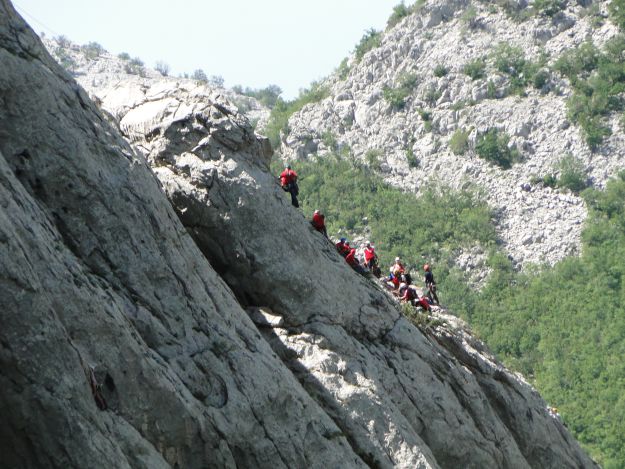
HGSS on a mission, clinging to a steep incline in Paklenica © HGSS The Croatian Mountain Rescue Service "People need to be aware at all times on the mountains. By the time most people think they may be in trouble, they've usually been in trouble for five or ten minutes already" Josip Granić.
80 – 85% of the people we rescue are Croatian. Only 15 – 20% are guests. People from Czech Republic, Slovakia, Poland, (Austria and Slovenia too) tend to enjoy nature more. They like hiking. That's the reason there are typically more rescues for those nationalities than there are for British, Belgian, French, Italian, America, Canadian or Australian guests. I don't remember the specific year, but sometime between 15 and 20 years ago we had a season where 5 or 6 Czech nationals were being searched for or, sadly, turned up dead. The media covered it and ever since there's been this myth that all the people who get into difficulty are Czech.
The question about expensive helicopter rides - why don't you charge the people you rescue - has been here forever. It's like this - if you're a tourist and you have a car accident in Croatia, the fire service, police and an ambulance will come. You won't get charged. We are a tourist country. According to international agreements, we are obliged to make everything safe for residents and guests alike. We are here, just like the fire service and police, to do our part. The Croatian air force is responsible for the helicopter rides and I have to give credit to them - they are crazy good pilots. Amazing. Even if we did charge everyone we saved - and most of the 85% of Croatians we save would struggle to pay - it still wouldn't be anywhere near the money required to run this service.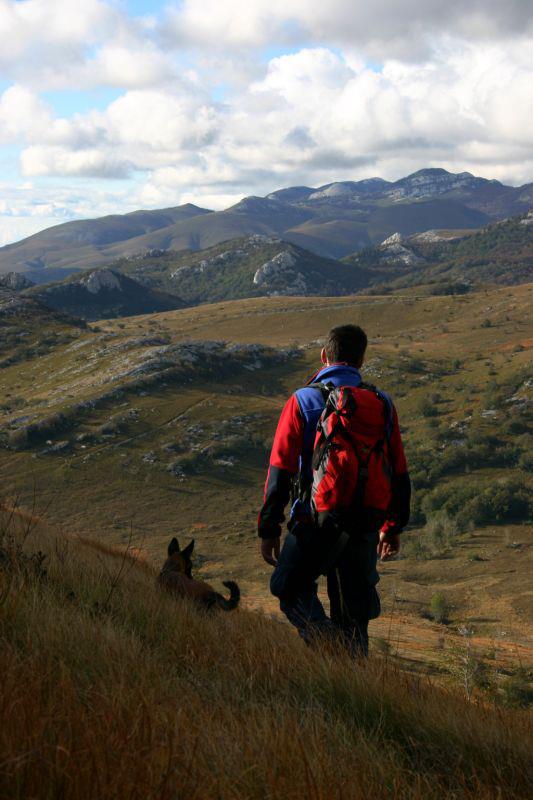
The Croatian Mountain Rescue Service used specially trained dogs on their searches © HGSS The Croatian Mountain Rescue Service
In 2007, I got a new search dog. It came from the Ogwen Valley Mountain Rescue service in North Wales. We cooperate a lot. We were sent out on a job to look for a three-year-old male child who had gone missing near Požega at the beginning of January, wintertime. His grandma was watching him and they were in a house on the edge of the woods. Early in the morning, he was playing with a dog. It suddenly ran into the forest and the boy chased after him. The grandmother didn't see it happen. I found him using my new dog, just after 8 o'clock the next morning. He'd been alone in the freezing forest for almost 20 hours.
Time is really moving fast on a job like that, because it's a kid and because it's so cold. Survival rates in such conditions are not good after 24 hours. When I found him, saw that he was alive, those big eyes looking up at me, it's a crazy feeling. You can't describe it. You can't compare it. A lot of positive emotions.
Every mission is special. We meet them all with the same level of determination and professionalism. But, it's the ones where you know you've really saved someone that stand out in the memory. Not the broken leg, where you transported someone – sure, that's an excellent job. But, when you know you've saved someone's life, that they definitely wouldn't be here now if it weren't for you, that's what makes it all worthwhile.
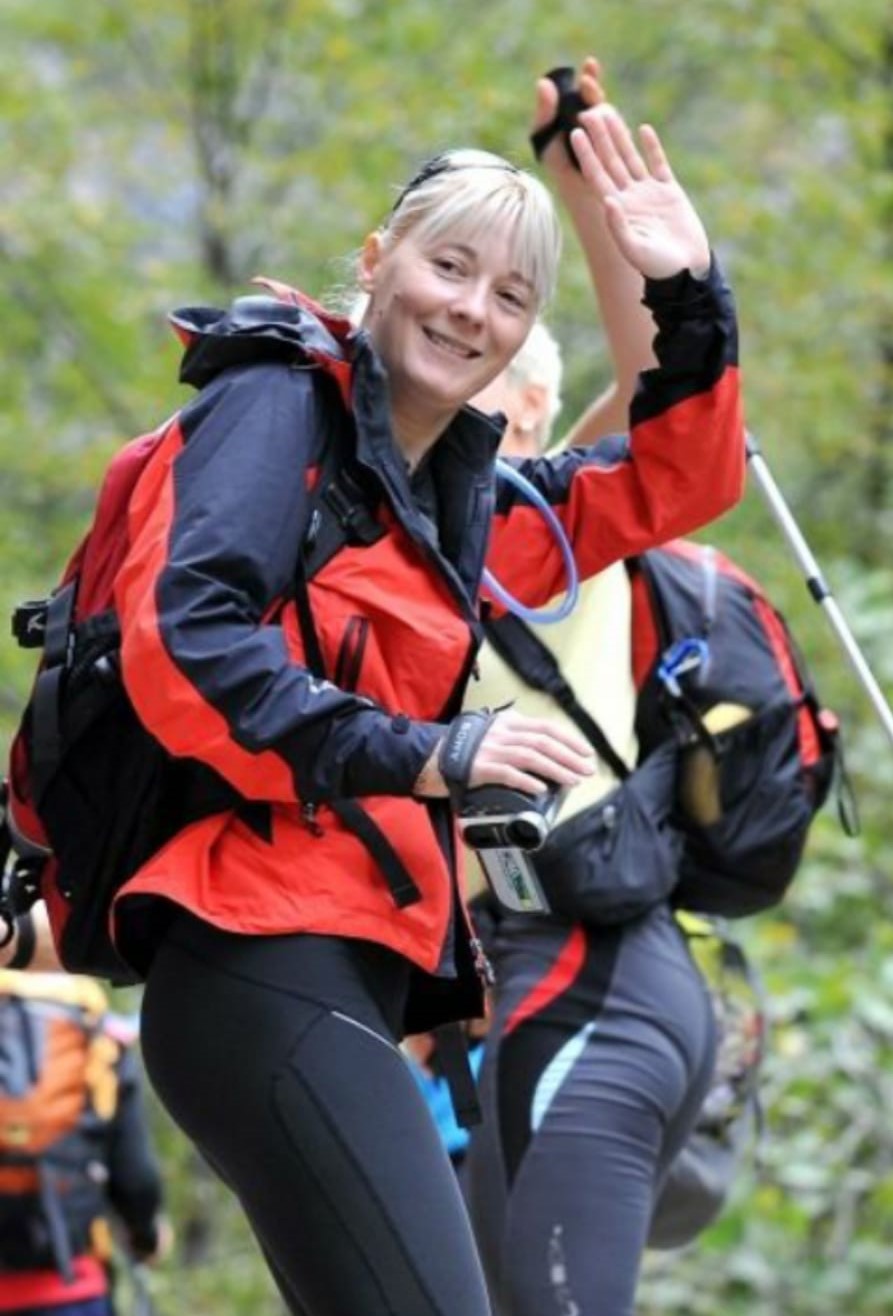
Jana Mijailović, volunteer for HGSS The Croatian Mountain Rescue Service
My name is Jana Mijailović, I'm 48 years old and I'm from Zadar. I finished school to be a teacher, but I never did it. My husband and I run a company that does plastic and aluminium windows for houses.
I started to go into the mountains when I was at high school. I never had the ambition to be part of mountain rescue services – people just noticed me on the mountains. They said I'd be good at it and asked me to join. I met my husband on the mountains. We are both volunteers for HGSS The Croatian Mountain Rescue Service. I've been doing it for 16 years.
I was a member of the first and second all-female Croatian expeditions to the Himalayas. We first climbed Cho Oyu in 2007, then Mount Everest in 2009. Croatia is the only country in the world that has only one successful male climber of Mount Everest, but four successful female climbers. I sometimes work as a guide too. I guess you could say I'm all about the mountains.
Being a climber, an Alpinist, I know that if I get into trouble, it's only my HGSS colleagues who can help. I feel this instinctively. I cannot be in the house, safe and warm, knowing that maybe someone needs help that only I can provide.
HGSS The Croatian Mountain Rescue Service members entering Paklenica under foreboding skies © HGSS The Croatian Mountain Rescue Service
I've really been on so many expeditions with HGSS. My station are on duty in the season at National Park Paklenica and I'm now the coordinator. Climbers from all around the world come and so there are many interventions. None of them are easy because the terrain is incredibly difficult. You really have to be in shape and know the techniques inside out.
I'm very proud of my statistics. Everyone I've rescued, who was alive when I reached them, is still living today. Unfortunately, not everyone we reach is alive when we arrive.
I remember one time, my husband and I were having dinner. We were arguing about the techniques and knots for moving a stretcher down a vertical climb. The training is so intense, you really have to know it well, and I guess that's just the kind of people that we are, that we would be arguing about it in our free time. Ha! He told me, "Why do you care? You'll never have to do that," because usually, it's really strong guys who do that specific job. If you're on a 400-metre-high section of rock, it really takes a lot of muscle.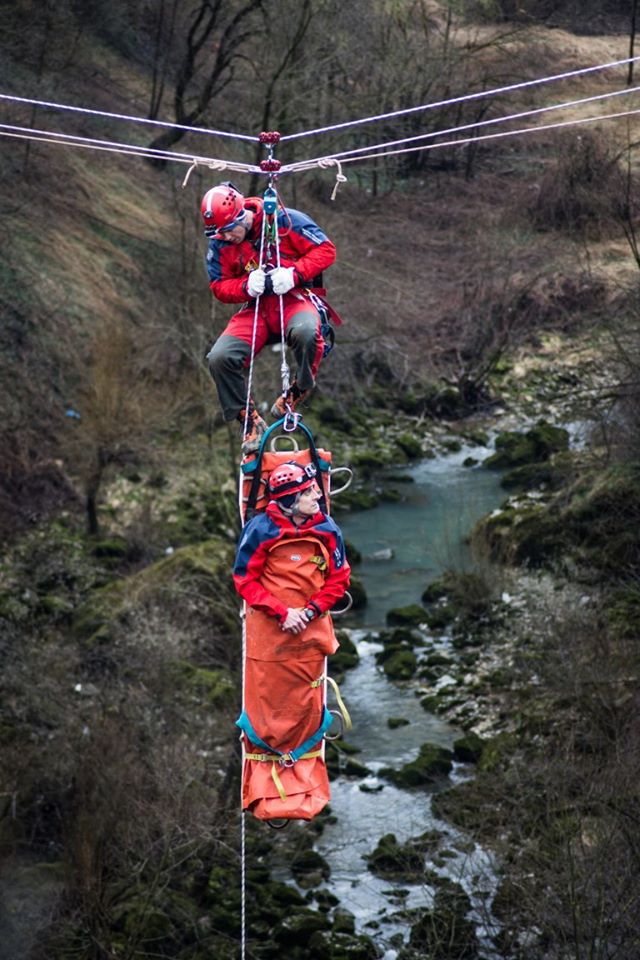
Ascending from a valley floor or descending from a mountain peak with a stretcher is a technically difficult operation, often hindered by darkness and adverse weather conditions. It requires a lot of training and a lot of muscle © HGSS The Croatian Mountain Rescue Service
In the evening, just two days later, we were called out to rescue an Italian guy who broke his leg on Anića Kuk. It's a really mighty part of the stone. And the leader of the expedition asked me to go on the stretcher. They pull you down on the ropes and you have to push very hard to keep the stretcher, the person you're carrying and yourself away from the rock, while balancing the weight of all three. It was dark, raining and with lots of Bura, the incredibly strong wind that sometimes hits us. That's probably my most memorable rescue.

Petar Prpić, firefighter and volunteer for HGSS The Croatian Mountain Rescue Service
My name is Petar Prpić, I'm 25 years old and I'm from Hrvatska Kostajnica, just on the Croatian-Bosnian border. My station is in Novska. In my full-time job I'm a professional firefighter. I guess I have two dangerous jobs. Well, one job and one hobby.
I've always been interested in the outdoors – mountaineering, hiking, canoeing. But, that's not why I joined HGSS The Croatian Mountain Rescue Service. I just wanted to help people. I don't know, I guess it's just something in me.
We have a lot of rivers in our area. During the times of flood, we get a lot of call-outs. Our part of the country has a high percentage of elderly people in the population. A lot of them live in small villages, on the edge of the forest. We get a lot of call-outs for searches. Especially in the autumn when people go out looking for chestnuts or mushrooms. But, like all the stations in Croatia, we are here year-round if there are any actions in other parts of the country that need us.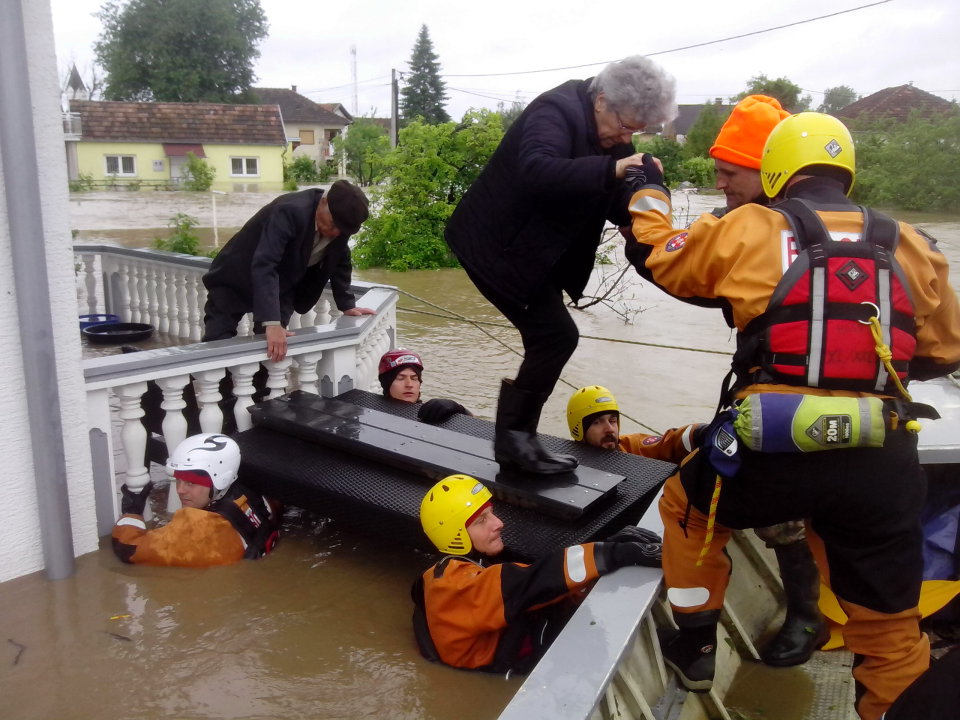
In some areas, HGSS The Croatian Mountain Rescue Service are frequently called out in response to flooding. This picture shows HGSS members on operation during the 2014 floods. In that year, flooding across the whole region was so bad that HGSS members operated not only in Croatia, but also donated their services to neighbouring Bosnia and Serbia © HGSS The Croatian Mountain Rescue Service
I was just on the search in Biokovo. The head of service called me and asked me to go. I first had to get some free days from my job. I called my boss, Zvonimir Ljubičić, chief of the fire department. He's great, very understanding, and he gave me permission. Two years ago I was called to Rab. Very hard operation, very difficult terrain.
Late last summer, we were called out to look for an older man near Glina. It was around 11 o'clock in the evening. He'd gone to look for mushrooms in the afternoon and never came back. Police were there and they sent for us.
The man had a cell phone on him, but there was no signal. There was no location given off the phone. We were a team of four, split into two teams. We went up into the woods above Glina and concentrated our search on areas where we could see there was no telephone signal on our phones. We were yelling in the dark. After an hour of search, someone answered. He'd been missing since 2pm. We found him at 2am. He was just lying there, uninjured but unwell, unable to move.
The reason it sticks in my mind is that the next day, in the morning, his daughter called me. She was so thankful, so emotional. For sure we saved his life. None of the other emergency services who were present could find him. It was down to us. We finished the operation at about 6am and then all four of us had to go immediately to our regular jobs.

Mario Franolić, physician, ex-commando and volunteer for HGSS The Croatian Mountain Rescue Service
My name is Mario Franolić and I'm 60 years old. I'm the chief of the mountain rescue service in Istria. I travel throughout Croatia because I'm also an instructor for the medical commission of HGSS. I was born on island Krk. I'm based in Pula although I work in Rijeka. I travel a lot between the two. I've been with HGSS The Croatian Mountain Rescue Service for 18 years.
In my day job, I'm a physician. I am a senior mentor at the Institute for Underwater and Hyperbaric Medecine in the Clinical Hospital Rijeka. I'm an expert in my field of emergency medecine. I've been doing it for almost 30 years.
When I was young, I trained to be a physician in Belgrade. It was then the best medical faculty in Yugoslavia. At the same time, I also started spelunking (cave exploration). I've been doing it since 1978. Later, I was a physician in the military underwater commando unit. I lived in Austria for five years, but when I came to Pula, they were just starting the HGSS The Croatian Mountain Rescue Service station here. They asked me for help because they didn't have any medical professional on the team. I accepted. It would be a waste not to use all these skills I have.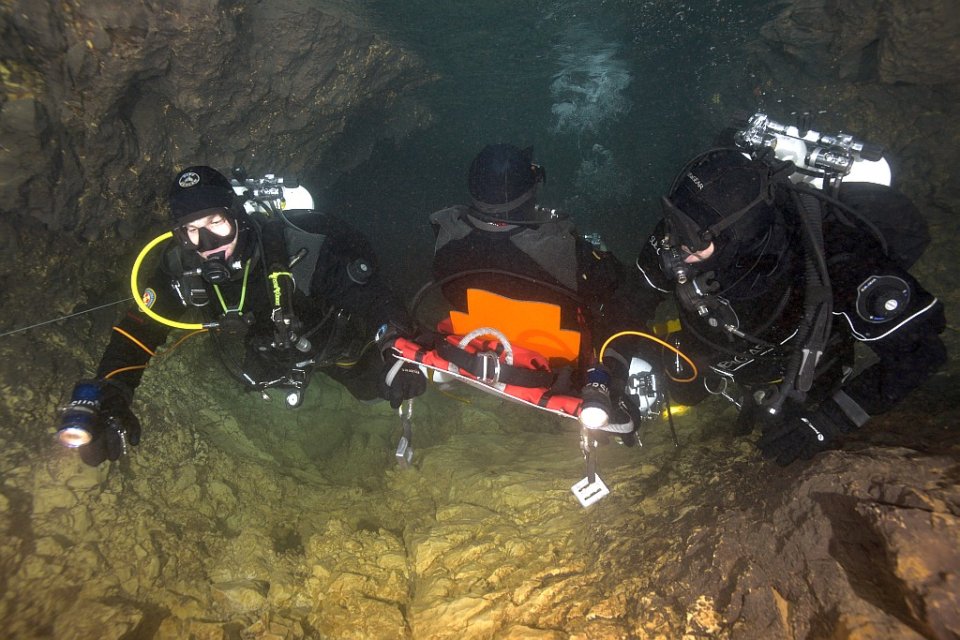
Specialist teams from HGSS are trained in underwater rescue from caves. Such caves exist all over Croatia in the karst rock, and also on some islands © HGSS The Croatian Mountain Rescue Service
Sometimes, our status as volunteers can give us problems. Although we have official duties, we are more like an NGO than something like the police. There can be legal implications. I remember one situation, very acute because a paraglider fell from the sky. None of his colleagues saw him fall. Paragliders go into the air together, but then they each branch off to do their own thing.
We had no idea about the location. We started from the last point of sighting, knowing that it could be very far from the place where he actually fell. But, we had to start somewhere. We had one mobile phone signal direction. But, you need three in order to locate someone. We only had a line on the map.
In the past, HGSS The Croatian Mountain Rescue Service sometimes had difficulties because the telephone companies wouldn't give us the information we needed in order to triangulate the position of a missing person. They would only give it to the police. But, it's a race against time. We searched for this man all day and all night. In the morning, some Croatian paragliders made private contact with a guy from the phone company. They begged him to release the information we needed. Although he could lose his job, giving such information to private citizens, he did it.
We found the man about 150 metres from where we were. Sadly, he was already dead. It was very small comfort to see that he had died instantly, on impact. It's unbearable when you reach someone you could have saved if only you had got there quicker, especially in an instance such as this, where we were hindered by a lack of information that was available. I think it moves more quickly now, but still we have to go through the police.
© HGSS The Croatian Mountain Rescue Service
One of the most emotional operations I went on was around five years ago, the rescue of a young girl - maybe two and a half to three years old – who got lost in the woods in a small place in central Istria. She chased into the forest after some dogs around 10 or 11 in the morning. The family saw immediately that she had disappeared and started to search. About two hours later, we were called out. It was impossible for the family to find her.
About 300 people came – my station, the Rijeka station, hunters, firemen, police and volunteers. In such an operation, the police are the lead service. But, 99% of the time they leave the organisation of the search to HGSS The Croatian Mountain Rescue Service. We are the only organisation who is very well educated in organising searches. When other people do searches, they use intuition. But, people all have different intuition. It can be chaotic. We are highly trained for this. There are procedures, recognised internationally, that we follow. We found her early in the morning, at around 7 o'clock. The dogs were lying on each side of her, giving her warmth.
All photos courtesy volunteers and HGSS The Croatian Mountain Rescue Service
Flights to Croatia: easyJet Closes Three UK Bases, Cancels Flights to Croatia
August 19, 2020 - The latest news from around Croatia’s airports for flights to Croatia with updates for Split, Dubrovnik, and Pula.
Croatian Aviation reports that British low-cost carrier easyJet issued a statement on its website on Tuesday announcing the imminent closure of its three large bases in the UK, solely due to reduced demand caused by the global coronavirus pandemic.
There are two airports in London, Stansted and Southend, and the company's base in Newcastle. From all three mentioned airports, there are direct easyJet flights to Croatia, more precisely, to Pula, Split and Dubrovnik.
“We had to take the very difficult decision to close three UK bases as a result of the unprecedented impact of the pandemic and related travel restrictions, compounded by quarantine measures in the UK which is impacting demand for travel. We would like to reassure customers due to fly from these airports that we are now contacting anyone whose flight is affected with clear advice on their options which include rerouting via alternative airports or receiving a full refund," easyJet CEO, Johan Lundgren, said.
The closure of these bases will happen very soon, as early as September 1, with the announcement that traffic from these airports will resume in the summer flight schedule in 2021. easyJet will operate on the following lines to Croatia until the end of August, and some of them have already been canceled.
- London Stansted - Dubrovnik
- London Stansted - Split
- London Southend - Dubrovnik
- London Southend - Pula
- Newcastle - Split
easyJet will operate from London (Gatwick Airport) to Dubrovnik, Split and Pula in September, so passengers planning a trip from Stansted or Southend Airport will be able to change their departure airport from London free of charge.
Passengers who have purchased a ticket on the line Newcastle - Split for September, will have to use the line from Manchester to arrive at Split Airport. That line will also run throughout September.
For the latest travel info, bookmark our main travel info article, which is updated daily.
Read the Croatian Travel Update in your language - now available in 24 languages
Flights to Croatia: Ryanair Announces New Line to Pula
August 17, 2020 - The latest news from around Croatia’s airports for flights to Croatia with updates for Pula.
Croatian Aviation reports that among the numerous cancellations and reductions of weekly flights to destinations in Croatia, there was some positive news. Ryanair has announced a new line to Pula for next spring.
Namely, the Irish low-cost airline plans to launch a new route between Pula and Vienna in the spring of 2021.
The Pula-Vienna route is currently planned from the first day of the summer flight schedule next year (March 28, 2021), twice a week, every Wednesday and Sunday, until autumn - specifically until the end of October (October 27, 2021).
The A320 aircraft of the partner company Lauda (pictured), which has its base at Vienna Airport, has been announced on the route. The capacity of the aircraft is 180 seats.
There have been no direct commercial flights between Vienna and Pula so far, but Austrian Airlines has previously operated charter flights from several destinations in Austria to Pula Airport.
This is the first announcement of a new line to Pula Airport for next year, but traffic will certainly depend on epidemiological measures in the next summer season.
This summer season, Ryanair connects Pula Airport with three international destinations: London, Berlin and Brussels.
In the first seven months of this year, Pula Airport had a turnover of 23,621 passengers, which is a decrease compared to last year of over 94%.
Recall, last week, TCN reported that British Airways would reduce the number of weekly flights to Zagreb in September this year.
British Airways currently operates daily between London (Heathrow Airport) and Zagreb, on A319 and A320 aircraft. Given the occupancy of the passenger cabin and reduced demand, the company decided to reduce the number of weekly flights on the said route in September this year.
From September 1 on the London - Zagreb route, British Airways aircraft will operate six times a week, every day except Wednesday, while from September 7, there will be five flights per week on the route. Namely, the flight will be additionally canceled on Tuesdays.
Changes are certainly still possible, but unfortunately not in the direction of increasing weekly flights, especially with the fact that the number of patients with COVID-19 in the Republic of Croatia is growing significantly.
Other British Airways routes in Croatia (to Dubrovnik, Split and Pula) have no operational changes so far.
Croatia Airlines currently offers three flights a week on the route Zagreb - London Heathrow throughout September (Monday, Wednesday, Friday), but the flight schedule for next month has not yet been finalized.
Furthermore, Aeroflot has completely canceled the Moscow - Split route, to which it planned to return in August, and there are no announced flights to Dubrovnik or Zagreb.
Before the pandemic, Russian Aeroflot operated daily on the Moscow (Sheremetyevo Airport) - Zagreb route, both in summer and winter.
The line was suspended at the time of the pandemic and has not resumed until now. However, according to the announcements from the airline, there will be no direct flights between the two capitals this year. The company plans to make a significant restructuring after the crisis, and according to current announcements, we can expect a direct air connection between Moscow and Zagreb only in April 2021.
Aeroflot even announced the launch of its seasonal route Moscow - Split in August this year, airline tickets were already on sale, but given the regulations at the state borders, it was to be expected that flights would be canceled, which eventually happened.
The third Aeroflot line in Croatia, the one to Dubrovnik, was withdrawn from sale in March, so Croatia will not have a direct connection with the capital of Russia this year.
In the summer flight schedule, the Croatian national carrier operates on the Zagreb - St. Petersburg line, but that line was also canceled for this year.
Aeroflot's last visit to Croatia was on May 2 this year, when a B777 aircraft landed at Zagreb Airport for the first time, transporting medical equipment from China via Moscow to the Croatian capital.
For the latest travel info, bookmark our main travel info article, which is updated daily.
Read the Croatian Travel Update in your language - now available in 24 languages!
Flights to Croatia: easyJet Adds Even More Flights from August
July 22, 2020 - The latest news from around Croatia’s airports for flights to Croatia with updates from Split, Dubrovnik, Zadar, and Pula.
Croatian Aviation reports that easyJet returned to Split at the beginning of July with six international flights to Split, and from the end of this month to Dubrovnik, Zadar and Pula. Now, in August, the low-cost airline will significantly increase the number of destinations and weekly flights to Croatian airports.
Lines to Zadar
Zadar - Amsterdam continues to operate 2 times a week,
Zadar - Basel continues to operate 3 times a week,
Zadar - Berlin continues to operate 1 week,
Zadar - London Luton continues to operate 2 times a week,
Zadar - London Gatwick is introduced, from July 25, twice a week (Tuesdays and Saturdays),
Lines to Pula
Pula - Amsterdam continues to operate 2 times a week,
Pula - Basel from August will operate 2 times a week,
Pula - Berlin continues to operate 1 time a week,
Pula - London Luton from August will run 3 times a week,
Pula - Bristol is introduced, from August 1, 2 times a week (Tuesdays and Saturdays),
Pula - Liverpool is introduced from August 2 two times a week (Wednesdays and Sundays),
Pula - London Gatwick is introduced from August 1, the line will operate 4 times a week (Mondays, Tuesdays, Saturdays and Sundays).
Lines to Dubrovnik
Dubrovnik - Amsterdam from August 2 will operate 4 times a week (Tuesdays, Thursdays, Saturdays and Sundays),
Dubrovnik - Edinburgh will operate 1 time a week,
Dubrovnik - London Gatwick will operate daily,
Dubrovnik - London Luton from August 1 will operate 1 time a week (Saturday), from August 20 the second weekly flight is added, Wednesday,
Dubrovnik - Manchester will run twice a week,
Milan - Dubrovnik will operate 2 times a week,
Dubrovnik - Basel is introduced, 1 time a week through August,
Dubrovnik - Belfast is introduced from August 2, 2 times a week (Wednesdays and Sundays),
Dubrovnik - Bristol is introduced from August 2, 3 times a week (Wednesdays, Fridays and Sundays),
Dubrovnik - Geneva is introduced from August 1, 1 time a week (Saturday),
Dubrovnik - Paris Orly is introduced from August 4, 3 times a week (Tuesdays, Thursdays and Sundays).
Lines to Split
Split - Amsterdam line will operate 6 times a week from August,
Split - Basel will operate daily from August,
Split - Berlin line continues to operate daily,
Split - Geneva continues to operate through August,
Split - London Gatwick from July 27 will operate daily,
Split - London Luton from July 22 will operate daily,
Split - Lyon continues to operate in August, 3 times a week,
Split - Manchester continues to operate through August, 3 times a week,
Split - Naples continues to operate through August,
Split - Paris line continues to operate through August,
Split - Bristol is introduced from August 1, 5 times a week (Mondays, Tuesdays, Thursdays, Saturdays and Sundays),
Split - Glasgow is introduced from August 2, 2 times a week (Wednesdays and Sundays),
Split - London Stansted is introduced from August 1, 4 times a week (Tuesdays, Thursdays, Saturdays and Sundays),
Split - Paris Orly is introduced, from July 24, 2 times a week. From August 3 flights a week (Mondays, Fridays and Sundays).
For the latest travel info, bookmark our main travel info article, which is updated daily.
Read the Croatian Travel Update in your language - now available in 24 languages
Join the Total Croatia Travel INFO Viber community.
Flights to Croatia: Transavia Alters Croatia Schedule, Air Explore to Split
July 17, 2020 - The latest news from around Croatia’s airports for flights to Croatia with updates from Split, Dubrovnik, Pula, Zadar, and Rijeka.
Croatian Aviation reports that Transavia, a low-cost airline with subsidiaries in France and the Netherlands, has made some changes to its flight schedule to destinations in Croatia.
At the end of June and the beginning of July, the company launched lines to Croatia, as many as 8 of them, and continues to operate on them through August.
The Paris Orly - Split route operates 3 times a week, but the company previously planned to increase it to as many as 6 weekly flights. This will not happen due to low demand. From August 13, the number of weekly flights will be reduced to 2.
The Rotterdam - Split line runs 5 times a week, and the same number of weekly flights is announced in August (every day except Monday and Wednesday).
The Nantes - Dubrovnik line continues to operate twice a week, as was announced earlier.
The Paris Orly - Dubrovnik line operates 3 times a week, and the company planned one more flight a week through August, but will keep the same number of operations (Fridays, Saturdays and Sundays).
The Rotterdam - Dubrovnik line continues to operate according to plan and through August, 2 times a week (Tuesdays and Saturdays).
The Rotterdam - Zadar line will hold three weekly flights in August (Mondays, Wednesdays and Saturdays).
The Rotterdam - Pula line will increase the number of weekly flights, from 3 to as many as 5, every day except Tuesdays and Wednesdays throughout August.
The Eindhoven - Rijeka line will continue to operate 3 times a week in August (Tuesdays, Thursdays and Sundays), which is one flight less per week compared to the 2019 season.
Furthermore, Croatian Aviation reports that the Slovak airline, Air Explore, announced its first scheduled flight to Croatia.
So far, the company has operated to Croatia on charter lines, mostly in the summer months, but will now launch the first regular line between Bratislava and Split.
The Bratislava - Split line will be in operation from Sunday, July 19, twice a week until the end of September this year. The line will operate twice a week, on Wednesdays and Sundays in the afternoon on B737-800 aircraft.
This is the first, completely new route introduced by the airline since the coronavirus pandemic.
For the latest travel info, bookmark our main travel info article, which is updated daily.
Read the Croatian Travel Update in your language - now available in 24 languages
Flights to Croatia: easyJet Returns to Dubrovnik, Zadar, Pula, Air France Boosts Summer Flights
July 12, 2020 - The latest news from around Croatia’s airports for flights to Croatia with updates from Zagreb, Split, Dubrovnik, Pula, and Zadar.
After we announced the flight schedule of low-cost airline easyJet to Split, Croatian Aviation reports that they decided to launch traffic to other airports in Croatia at the end of this month.
easyJet will additionally return to Dubrovnik, Zadar and Pula, but in a significantly reduced form, with very few destinations and a small number of weekly flights compared to the 2019 season.
Lines to Dubrovnik
Amsterdam - Dubrovnik, from July 23, twice a week, on Thursdays and Sundays, from July 28 four times a week, on Tuesdays, Thursdays, Saturdays and Sundays,
Edinburgh - Dubrovnik, from July 21, twice a week, Tuesdays and Saturdays,
Manchester - Dubrovnik, from July 22, twice a week, Wednesdays and Saturdays,
Naples - Dubrovnik, from July 20, twice a week, Mondays and Fridays.
Return to Pula
Amsterdam - Pula, from July 22, twice a week, Wednesdays and Saturdays,
London Luton - Pula, from July 25, once a week, Saturdays,
Basel - Pula, from July 25, once a week, on Saturdays,
Berlin - Pula, from July 25, once a week, on Saturdays.
Lines to Zadar
Amsterdam - Zadar, from July 26, twice a week, on Tuesdays and Saturdays,
Basel - Zadar, from July 25, three times a week, on Mondays, Thursdays and Saturdays,
Berlin - Zadar, from July 25, once a week, on Saturdays,
London Luton - Zadar, from July 25, twice a week, Wednesdays and Saturdays.
The company will launch 12 international routes to the 3 mentioned airports, not including Split to which easyJet has been flying since the beginning of July this year. Changes are still possible and depend on the epidemiological situation in Croatia.
Croatian Aviation also reports that Air France started traffic to Croatia at the beginning of July (except for Split, which will begin in the middle of the month), and the company has already announced an increase in the number of weekly flights:
From August 1, the Paris-Dubrovnik line will operate four times a week (until then only two flights a week), on Mondays, Fridays, Saturdays and Sundays.
From July 27, the Paris-Split line will operate as many as 6 times a week (until the specified date 3 times a week), every day except Saturday.
The Paris-Zagreb route currently operates four times a week, but as of July 27, there will be as many as 11 flights a week on the route. Namely, Air France will significantly increase the number of flights, introducing two flights a day every Monday, Wednesday, Friday and Sunday, while on Tuesdays, Thursdays and Saturdays, it will operate once a day.
Aircraft type A319 / 320/321 has been announced on all routes to Croatia, while aircraft of smaller capacity, type E190, will operate towards Split.
Furthermore, British TUI, an extremely important airline that normally operates to 4 airports in Croatia during the summer flight schedule; Dubrovnik, Split, Rijeka and Pula, will likely not start regular traffic to destinations in Croatia this summer.
Croatian Aviation reports that due to the impact of the pandemic, the company grounded its fleet and canceled numerous destinations in its network, including those in Croatia.
This summer, TUI will not operate on as many as 8 lines to Dubrovnik:
London (Gatwick) - Dubrovnik,
Cardiff - Dubrovnik,
Glasgow - Dubrovnik,
Manchester - Dubrovnik,
Birmingham - Dubrovnik,
Bristol - Dubrovnik
Sheffield - Dubrovnik,
East Midlands - Dubrovnik.
It is important to note that all routes to Dubrovnik from Great Britain had one or two flights a week, they were mainly used to transport tourists from the TUI group (cruisers and packages that include hotel accommodation), and wide-body aircraft came to Dubrovnik regularly, like the B787-8 or even a larger version of B787-9.
As for Split Airport, 3 lines have been canceled:
London (Gatwick) - Split,
Birmingham - Split,
Manchester - Split.
At Pula Airport, TUI canceled 6 lines:
London (Gatwick) - Pula,
Birmingham - Pula,
Bristol - Pula,
Sheffield - Pula,
East Midlands - Pula,
Manchester - Pula.
TUI used wide-body aircraft, mostly B787-8. The only line to Rijeka (London Gatwick - Rijeka) has also been canceled for this summer season.
In addition to the significant loss for airports to which TUI UK normally flies in the summer flight schedule, the loss is even greater for the tourism sector, which has collaborated with this company in the sale of travel arrangements.
Finally, Croatian Aviation reports that Italian national airline Alitalia has announced its modified flight schedule for August, which has no destinations in Croatia.
The company will significantly increase the number of destinations from August, mainly to destinations from which many tourists traditionally come to Italy (a significant increase in weekly flights to Asia and the USA).
During the summer flight schedule, the company operated to Split and Dubrovnik from Rome (Leonardo da Vinci Airport - Fiumicino). The lines are not currently in operation, and the company does not intend to launch them in August, either. Given that both lines were in operation until the end of September, we can expect that the well-known Italian company will not return to Croatia this year.
Croatia Airlines operates from Zagreb via Split and Dubrovnik to Rome, and on direct flights from Rome to Croatia, there is also Vueling, so passengers who want to travel between Croatia and Italy have a choice in the form of direct flights, as well as those with one stop on the way from or towards Zagreb.
For the latest travel info, bookmark our main travel info article, which is updated daily.
Read the Croatian Travel Update in your language - now available in 24 languages
Flights to Croatia: SAS Pushes Back on Launching Numerous Seasonal Routes to Croatia
July 7, 2020 - The latest news from around Croatia’s airports for flights to Croatia with updates from Split, Dubrovnik, Zadar, and Pula.
Croatian Aviation reports that as confirmed by SAS, due to the impact of the coronavirus pandemic and reduced demand, the company does not plan to launch numerous seasonal routes to Croatia from Scandinavia in this year's summer flight schedule.
In the summer flight schedule, Scandinavian Airlines operates from numerous airports in Scandinavia to Pula, Split and Dubrovnik, though the company decided against launching numerous lines to Croatia this time around.
For the latest travel info, bookmark our main travel info article, which is updated daily.
Read the Croatian Travel Update in your language - now available in 24 languages
Join the Total Croatia Travel INFO Viber community.
SAS already operates on several lines to Croatia, from Copenhagen, Oslo and Stockholm to Split, and from Copenhagen to Pula.
The company has no plans to launch flights to Dubrovnik in July, and it is almost certain that many other routes will also not be in this year's summer flight schedule.
Numerous lines to Split have been canceled
In the summer flight schedule, SAS operated from as many as 9 destinations to Split, while this year only 3 previously mentioned lines will be in traffic.
The company does not plan to launch lines from Tromso, Harstad, Alesund, Trondheim, Bergen, Stavanger, Kristiansand, Aarhus and Gothenburg to Split this year. However, from most of the mentioned destinations, it is possible to travel with one transfer via Copenhagen, Oslo or Stockholm, also with SAS.
Lines from Copenhagen, Oslo and Stockholm to Dubrovnik are also not on sale and will most likely not be available this year.
Pula Airport and SAS
Pula has been connected to Bergen, Oslo, Stavanger, Gothenburg and Copenhagen in previous summer seasons, but SAS operates only on the line from Copenhagen to Pula and does not plan to launch other lines this summer.
Zadar - a newly planned destination
This summer, the company planned to introduce the Copenhagen - Zadar route and thus add another Croatian airport to its destination network. The flights were originally planned twice a week, but have been completely withdrawn from sale for this year.
Flights to Croatia: Jet2 Announces 12 Lines to Split, Dubrovnik, and Pula
July 6, 2020 - The latest news from around Croatia’s airports for flights to Croatia with updates from Split, Dubrovnik and Pula.
Croatian Aviation reports that the British leisure airline, Jet2, is introducing numerous routes from the UK to Dubrovnik, Split and Pula.
Following the decision to lift the mandatory 14-day self-isolation upon arrival in the UK from Croatia, the company has confirmed the launch of its seasonal lines by which many British tourists come on holiday to Croatia.
For the latest travel info, bookmark our main travel info article, which is updated daily.
Read the Croatian Travel Update in your language - now available in 24 languages
Join the Total Croatia Travel INFO Viber community.
From mid-July, Jet2 will launch as many as 12 direct lines from Great Britain to Dubrovnik, Split and Pula. Certain routes have been canceled, while the number of weekly flights has been reduced for all routes.
Lines to Dubrovnik
the Birmingham - Dubrovnik line is introduced, once a week, on Saturdays, from July 18,
the London - Dubrovnik line is introduced, once a week, on Saturdays, from July 18,
the Manchester - Dubrovnik line is introduced, 3 times a week (Thu, Sat, Sun), from July 16,
the Newcastle - Dubrovnik line is introduced, once a week, on Sundays, from 19 July.
Lines to Split
the Birmingham - Split line is introduced, twice a week (Wed, Sun), from July 15,
the East Midlands - Split line is introduced, once a week, on Sundays, from July 19,
the Leeds - Split line is introduced, once a week, on Saturdays, from July 18,
the London - Split line is introduced, once a week, on Sundays, from July 19,
the Manchester - Split line is introduced, twice a week (Tue, Sat), from July 18.
Lines to Pula
the Birmingham - Pula line is introduced, once a week, on Sundays, from July 19,
the Leeds - Pula line is introduced, once a week, on Sundays, from July 19,
the Manchester - Pula line is introduced, twice a week (Thu, Sun), from July 19.
B737-800 aircraft with a capacity of 189 seats in the fleet of this carrier has been announced on the routes.
Flights to Croatia: Windrose and SAS to Pula, Iberia Delays Zagreb Service to Winter
June 24, 2020 - The latest news from around Croatia’s airports for flights to Croatia with updates from Zagreb and Pula.
Croatian Aviation reports that Windrose and Scandinavian Airlines (SAS) have announced the launch of direct international flights to Pula Airport.
Namely, Windrose and SAS will launch direct flights to Pula at the very beginning of July. More specifically, on Saturday, July 4, the A320neo will operate on Scandinavian Airlines and the A321 on Windrose Airlines.
For the latest travel info, bookmark our main travel info article, which is updated daily.
Read the Croatian Travel Update in your language - now available in 24 languages
Join the Total Croatia Travel INFO Viber community.
From July 4, Scandinavian Airlines will introduce the Copenhagen - Pula route, once a week (every Saturday), though the route will probably be intensified with more weekly flights in the coming period. SAS announced the A320neo aircraft on this route.
Recall, yesterday, we announced that SAS released a modified flight schedule for July, in which the number of weekly flights to Split has increased significantly.
The company has decided to increase the number of weekly flights and add a route from Stockholm to Split, so SAS will connect Split with Scandinavia according to the following schedule:
Copenhagen - Split, from June 29, daily (so far twice a week)
Oslo - Split, from June 29, six times a week, except Thursdays (so far once a week).
SAS will also introduce Stockholm - Split, from July 1, which will operate daily.
From the same date, Jule 4, Windrose Airlines plans to launch the Kyiv-Pula route, also once a week (Saturday), with the A321 aircraft, but the second weekly flight (Tuesday) is also on sale, from July 21.
Furthermore, Ex Yu Aviation reports that Spanish airline Iberia will not resume the Madrid - Zagreb service until the start of the 2020/2021 winter season.
Namely, Iberia will resume the route on October 23 with three flights per week, on Tuesday, Friday and Sunday.
In 2019, Iberia carried 47,703 passengers between Madrid and Zagreb. Iberia will resume seasonal flights to Dubrovnik on July 17, though services to Split and Zadar have not yet been scheduled.
Former Volkswagen Executive Ends Up in Custody in Pula - Newspaper
ZAGREB, June 18, 2020 - Axel Eiser, a former executive at Volkswagen and Audi, was arrested at the Kastel-Dragonja border crossing with Slovenia last week and placed in investigative custody in Pula, the Vecernji List newspaper reported on Thursday.
Eiser, former head of engine development at one of the world's biggest automobile companies, is wanted by the United States in connection with 2015's emissions test scam known as Dieselgate.
An investigation found that Volkswagen had programmed diesel engines to activate their emissions controls during emissions testing, tricking inspectors into thinking that they complied with emissions rules. The cars actually emitted far more pollution while on the road.
As a result, Volkswagen has paid $33 billion in fines. So far only a small number of executives have been arrested, while others have evaded justice for now because Germany does not extradite its own citizens.
Explaining the extradition procedure, Kresimir Devcic, investigating judge at Zagreb County Court, said that Eiser can appeal the detention order. After that the United States will be asked to provide all relevant documents within 40 days, together with an extradition request. The court then rules on the request and the ruling is subject to an appeal, after which the justice minister decides on extradition.
Devcic said that a problem could arise if Germany also asked for the extradition of its citizen, in which case Croatia would find itself "between a rock and a hard place" and the decision would again have to be made by the justice minister.
"The Justice Ministry has not yet received the extradition request, and when we receive one, it will be decided by the court first, so we should wait and see what it will decide. This will be followed by the appeal process and the entire legal procedure, so that for now it is too soon to comment on this case," Justice Minister Drazen Bosnjakovic said on Wednesday.
It could take months before this case is decided and until then one of the most powerful people of Volkswagen and Audi will stay in jail in Pula, Vecernji List said.


